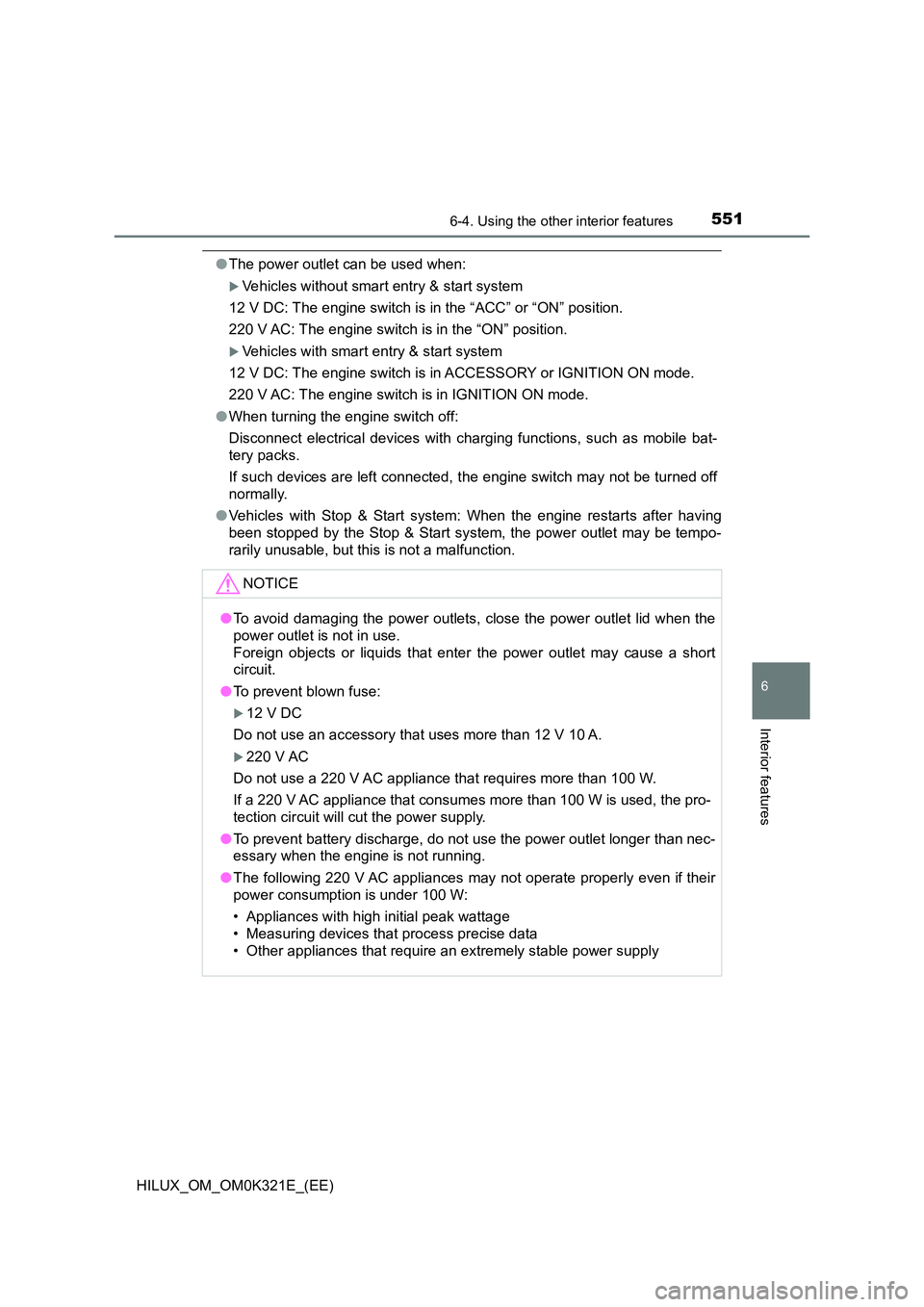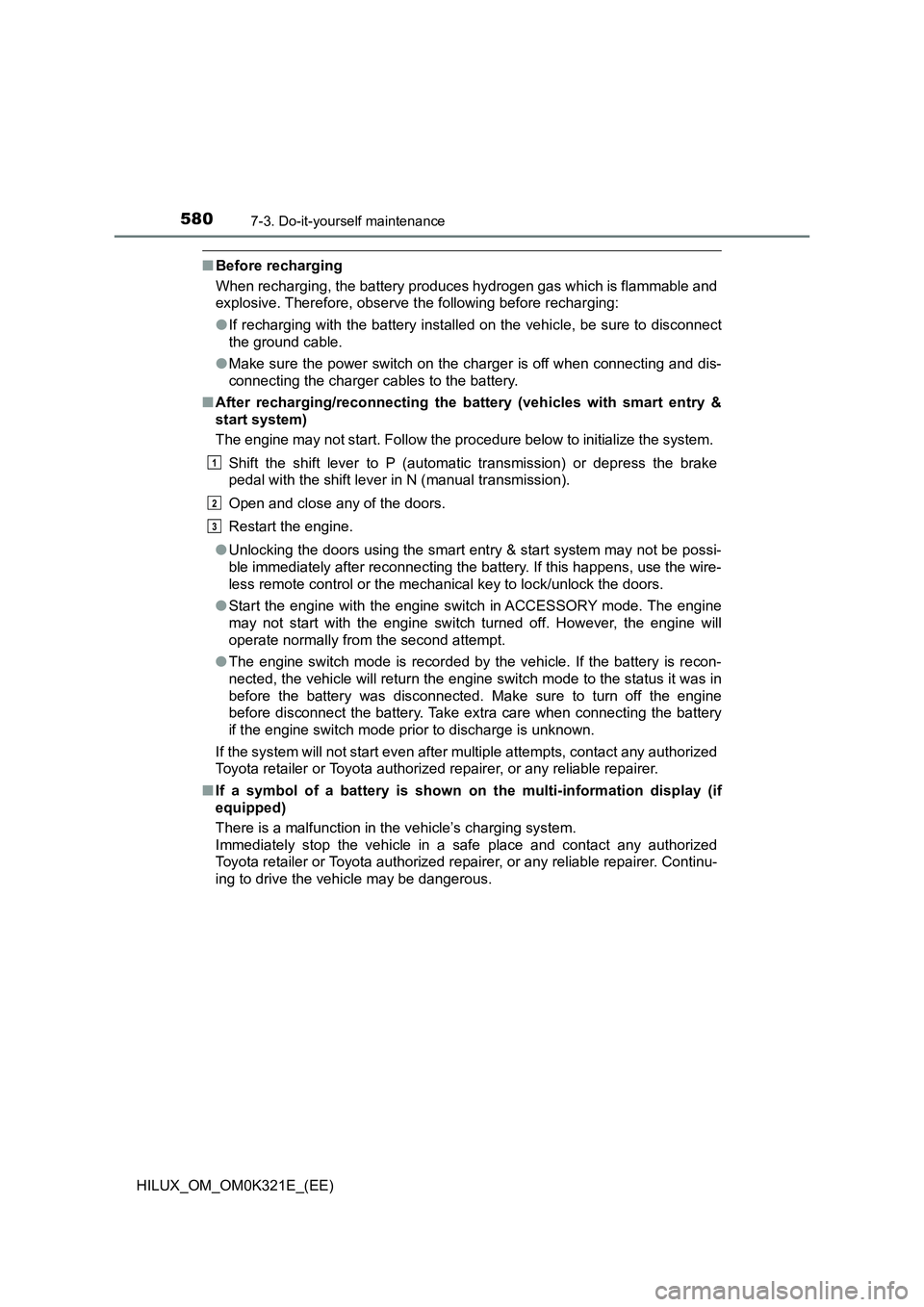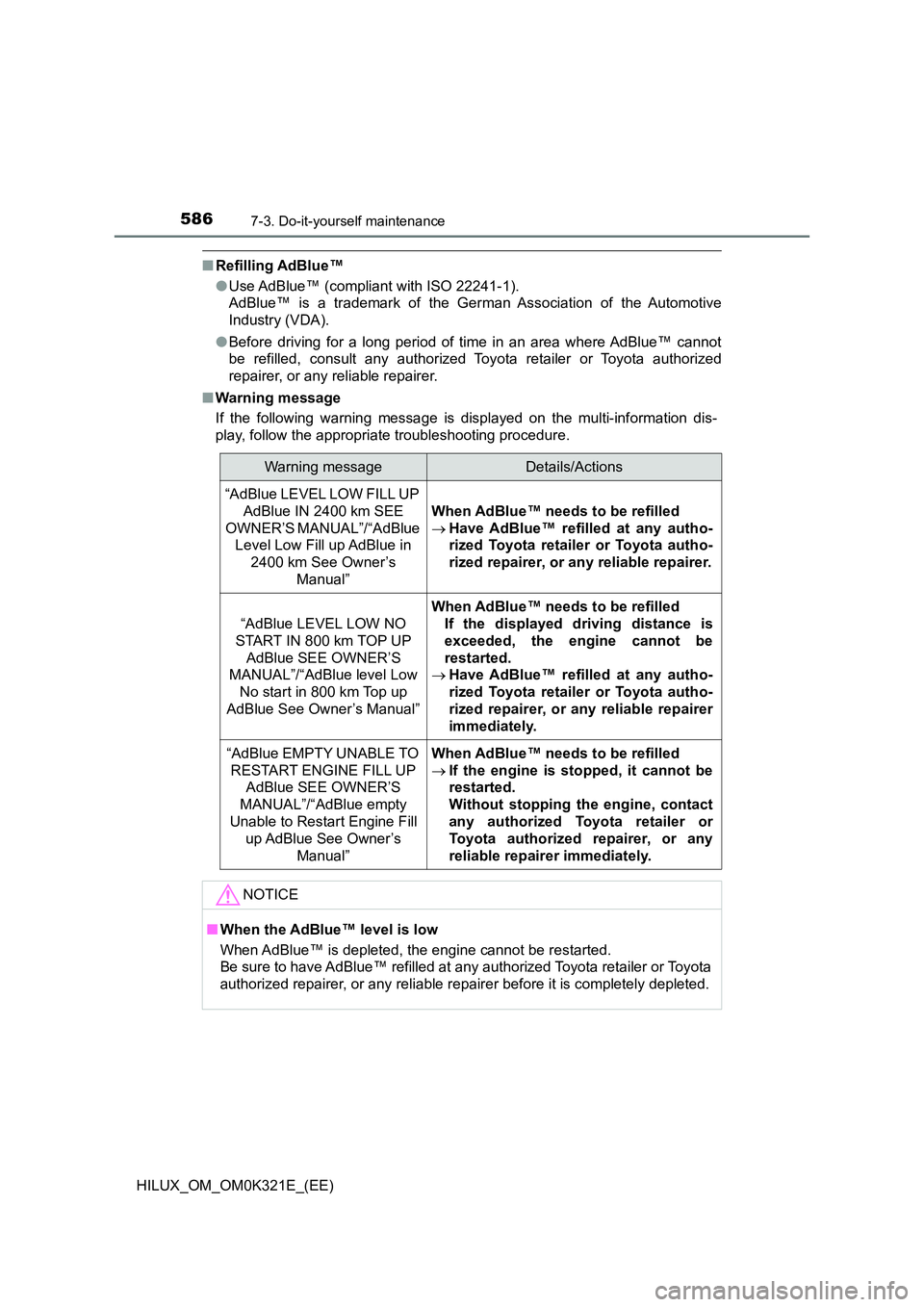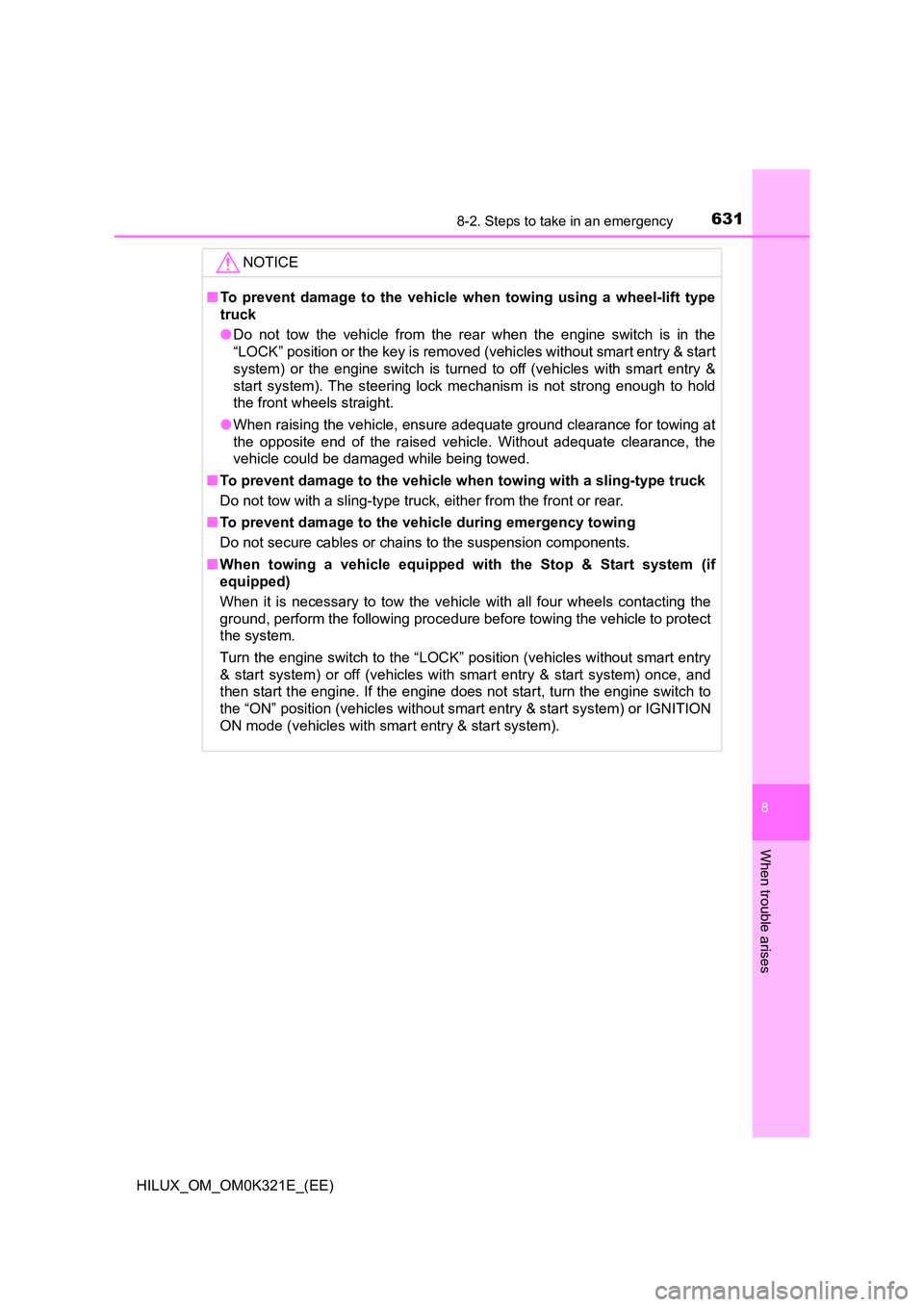2020 TOYOTA HILUX stop start
[x] Cancel search: stop startPage 551 of 744

5516-4. Using the other interior features
HILUX_OM_OM0K321E_(EE)
6
Interior features
●The power outlet can be used when:
Vehicles without smart entry & start system
12 V DC: The engine switch is in the “ACC” or “ON” position.
220 V AC: The engine switch is in the “ON” position.
Vehicles with smart entry & start system
12 V DC: The engine switch is in ACCESSORY or IGNITION ON mode.
220 V AC: The engine switch is in IGNITION ON mode.
● When turning the engine switch off:
Disconnect electrical devices with charging functions, such as mobile bat-
tery packs.
If such devices are left connected, the engine switch may not be turned off
normally.
● Vehicles with Stop & Start system: When the engine restarts after having
been stopped by the Stop & Start system, the power outlet may be tempo-
rarily unusable, but this is not a malfunction.
NOTICE
● To avoid damaging the power outlets, close the power outlet lid when the
power outlet is not in use.
Foreign objects or liquids that enter the power outlet may cause a short
circuit.
● To prevent blown fuse:
12 V DC
Do not use an accessory that uses more than 12 V 10 A.
220 V AC
Do not use a 220 V AC appliance that requires more than 100 W.
If a 220 V AC appliance that consumes more than 100 W is used, the pro-
tection circuit will cut the power supply.
● To prevent battery discharge, do not use the power outlet longer than nec-
essary when the engine is not running.
● The following 220 V AC appliances may not operate properly even if their
power consumption is under 100 W:
• Appliances with high initial peak wattage
• Measuring devices that process precise data
• Other appliances that require an extremely stable power supply
Page 580 of 744

5807-3. Do-it-yourself maintenance
HILUX_OM_OM0K321E_(EE)
■Before recharging
When recharging, the battery produces hydrogen gas which is flammable and
explosive. Therefore, observe the following before recharging:
● If recharging with the battery installed on the vehicle, be sure to disconnect
the ground cable.
● Make sure the power switch on the charger is off when connecting and dis-
connecting the charger cables to the battery.
■ After recharging/reconnecting the battery (vehicles with smart entry &
start system)
The engine may not start. Follow the procedure below to initialize the system.
Shift the shift lever to P (automat ic transmission) or depress the brake
pedal with the shift lever in N (manual transmission).
Open and close any of the doors.
Restart the engine.
● Unlocking the doors using the smart entry & start system may not be possi-
ble immediately after reconnecting the battery. If this happens, use the wire-
less remote control or the mechanical key to lock/unlock the doors.
● Start the engine with the engine switch in ACCESSORY mode. The engine
may not start with the engine switch turned off. However, the engine will
operate normally from the second attempt.
● The engine switch mode is recorded by the vehicle. If the battery is recon-
nected, the vehicle will return the engine switch mode to the status it was in
before the battery was disconnected. Make sure to turn off the engine
before disconnect the battery. Take extra care when connecting the battery
if the engine switch mode prior to discharge is unknown.
If the system will not start even after multiple attempts, contact any authorized
Toyota retailer or Toyota authorized repairer, or any reliable repairer.
■ If a symbol of a battery is shown on the multi-information display (if
equipped)
There is a malfunction in the vehicle’s charging system.
Immediately stop the vehicle in a safe place and contact any authorized
Toyota retailer or Toyota authorized repai rer, or any reliable repairer. Continu-
ing to drive the vehicle may be dangerous.
1
2
3
Page 586 of 744

5867-3. Do-it-yourself maintenance
HILUX_OM_OM0K321E_(EE)
■Refilling AdBlue™
● Use AdBlue™ (compliant with ISO 22241-1).
AdBlue™ is a trademark of the German Association of the Automotive
Industry (VDA).
● Before driving for a long period of time in an area where AdBlue™ cannot
be refilled, consult any authorized Toyota retailer or Toyota authorized
repairer, or any reliable repairer.
■ Warning message
If the following warning message is displayed on the multi-information dis-
play, follow the appropriate troubleshooting procedure.
Warning messageDetails/Actions
“AdBlue LEVEL LOW FILL UP
AdBlue IN 2400 km SEE
OWNER’S MANUAL”/“AdBlue
Level Low Fill up AdBlue in
2400 km See Owner’s
Manual”
When AdBlue™ needs to be refilled
Have AdBlue™ refilled at any autho-
rized Toyota retailer or Toyota autho-
rized repairer, or any reliable repairer.
“AdBlue LEVEL LOW NO
START IN 800 km TOP UP
AdBlue SEE OWNER’S
MANUAL”/“AdBlue level Low
No start in 800 km Top up
AdBlue See Owner’s Manual”
When AdBlue™ needs to be refilled
If the displayed driving distance is
exceeded, the engine cannot be
restarted.
Have AdBlue™ refilled at any autho-
rized Toyota retailer or Toyota autho-
rized repairer, or any reliable repairer
immediately.
“AdBlue EMPTY UNABLE TO
RESTART ENGINE FILL UP
AdBlue SEE OWNER’S
MANUAL”/“AdBlue empty
Unable to Restart Engine Fill
up AdBlue See Owner’s
Manual”
When AdBlue™ needs to be refilled
If the engine is stopped, it cannot be
restarted.
Without stopping the engine, contact
any authorized Toyota retailer or
Toyota authorized repairer, or any
reliable repairer immediately.
NOTICE
■ When the AdBlue™ level is low
When AdBlue™ is depleted, the engine cannot be restarted.
Be sure to have AdBlue™ refilled at any authorized Toyota retailer or Toyota
authorized repairer, or any reliable repairer before it is completely depleted.
Page 589 of 744

5897-3. Do-it-yourself maintenance
HILUX_OM_OM0K321E_(EE)
7
Maintenance and care
Close the AdBlue™ tank cap.
Turn the cap until you hear a
click.
Check that the engine starts.
The way of refilling may differ from those shown in the illustration.
■ When refilling AdBlue™
After refilling AdBlue™, the engine may take a few seconds longer than nor-
mal to start.
6
NOTICE
■ When refilling AdBlue™
Observe the following precautions.
Failure to do so may result in damage to the vehicle parts, paint, etc.
● Do not use urea solution other than AdBlue™.
● If AdBlue™ comes into contact with any painted surfaces on the vehicle,
immediately wash the affected areas with water.
● If AdBlue™ is spilled inside the engine compartment, immediately wipe it
with a wet cloth.
■ When refilling AdBlue™ with the refilling equipment
Observe the following precautions to prevent AdBlue™ overflowing from the
AdBlue™ tank:
● Securely insert the nozzle into the AdBlue™ filler neck.
● Stop filling the tank after the nozzle automatically clicks off.
● Do not top off the AdBlue™ tank.
■ When storing AdBlue™ containers
Observe the following precautions.
Failure to do so may result in damage to vehicle parts, paint, etc., and
changes in the chemical compounds of AdBlue™ may cause unpleasant
odors.
● Do not leave AdBlue™ containers inside the vehicle.
● Tightly seal AdBlue™ containers and store them in a cool, dry location
with good ventilation and no exposure to direct sunlight.
7
Page 623 of 744

623
8When trouble arises
HILUX_OM_OM0K321E_(EE)
8-1. Essential information
Emergency flashers ........... 624
If your vehicle has to
be stopped in an
emergency ....................... 625
8-2. Steps to take in an
emergency
If your vehicle needs
to be towed ...................... 627
If you think something is
wrong ............................... 632
Fuel pump shut off
system (gasoline engine
only) ................................. 633
If a warning light turns on
or a warning buzzer
sounds ............................. 634
If a warning message is
displayed ......................... 643
If you have a flat tire .......... 649
If the engine will not
start.................................. 666
If the electronic key does
not operate properly
(vehicles with smart
entry & start system)........ 668
If the vehicle battery is
discharged ....................... 672
If your vehicle
overheats ......................... 678
If you run out of fuel
and the engine stalls
(diesel engine only) ......... 682
If the vehicle becomes
stuck ................................ 683
Page 625 of 744

6258-1. Essential information
HILUX_OM_OM0K321E_(EE)
8
When trouble arises
If your vehicle has to be stopped in an
emergency
Steadily step on the brake pedal with both feet and firmly depress it.
Do not pump the brake pedal repeatedly as this will increase the effort
required to slow the vehicle.
Shift the shift lever to N.
If the shift lever is shifted to N
After slowing down, stop the vehicle in a safe place by the road.
Stop the engine.
If the shift lever cannot be shifted to N
Keep depressing the brake pedal with both feet to reduce vehicle
speed as much as possible.
Vehicles without smart entry &
start system:
Stop the engine by turning the
engine switch to the “ACC”
position.
Vehicles with smart entry &
start system:
To stop the engine, press and
hold the engine switch for 2
consecutive seconds or more,
or press it briefly 3 times or
more in succession.
Stop the vehicle in a safe place by the road.
Only in an emergency, such as if it becomes impossible to stop
the vehicle in the normal way, stop the vehicle using the follow-
ing procedure:
1
2
3
4
3
4
Press and hold for 2 seconds or
more, or press briefly 3 times or
more
5
Page 629 of 744

6298-2. Steps to take in an emergency
HILUX_OM_OM0K321E_(EE)
8
When trouble arises
If a tow truck is not available in an emergency, your vehicle may be
temporarily towed using cables or chains secured to the emergency
towing hooks. This should only be attempted on hard surfaced roads
for at most 80 km (50 miles) at under 30 km/h (18 mph).
A driver must be in the vehicle to steer and operate the brakes. The
vehicle’s wheels, drive train, axles, steering and brakes must be in
good condition.
Securely attach cables or
chains to the towing hooks.
Take care not to damage the vehi-
cle body.
Enter the vehicle being towed and start the engine.
If the engine does not start, turn the engine switch to the “ON” position
(vehicles without smart entry & start system) or IGNITION ON mode (vehi-
cles with smart entry & start system).
Vehicles with Stop & Start system:
Before towing the vehicle, turn the engine switch to the “LOCK” position
(vehicles without smart entry & start system) or off (vehicles with smart
entry & start system) once, and then start the engine.
4WD models: Turn the front-wheel drive control switch to H2.
( P. 398)
Shift the shift lever to N and release the parking brake.
When the shift lever cannot be shifted (automatic transmission):
P. 2 9 8
Emergency towing
Emergency towing procedure
1
2
3
4
Page 631 of 744

6318-2. Steps to take in an emergency
HILUX_OM_OM0K321E_(EE)
8
When trouble arises
NOTICE
■To prevent damage to the vehicle when towing using a wheel-lift type
truck
● Do not tow the vehicle from the rear when the engine switch is in the
“LOCK” position or the key is removed (vehicles without smart entry & start
system) or the engine switch is turned to off (vehicles with smart entry &
start system). The steering lock mechanism is not strong enough to hold
the front wheels straight.
● When raising the vehicle, ensure adequate ground clearance for towing at
the opposite end of the raised vehicle. Without adequate clearance, the
vehicle could be damaged while being towed.
■ To prevent damage to the vehicle when towing with a sling-type truck
Do not tow with a sling-type truck, either from the front or rear.
■ To prevent damage to the vehicle during emergency towing
Do not secure cables or chains to the suspension components.
■ When towing a vehicle equipped with the Stop & Start system (if
equipped)
When it is necessary to tow the vehicle with all four wheels contacting the
ground, perform the following procedure before towing the vehicle to protect
the system.
Turn the engine switch to the “LOCK” position (vehicles without smart entry
& start system) or off (vehicles with smart entry & start system) once, and
then start the engine. If the engine does not start, turn the engine switch to
the “ON” position (vehicles without smart entry & start system) or IGNITION
ON mode (vehicles with smart entry & start system).